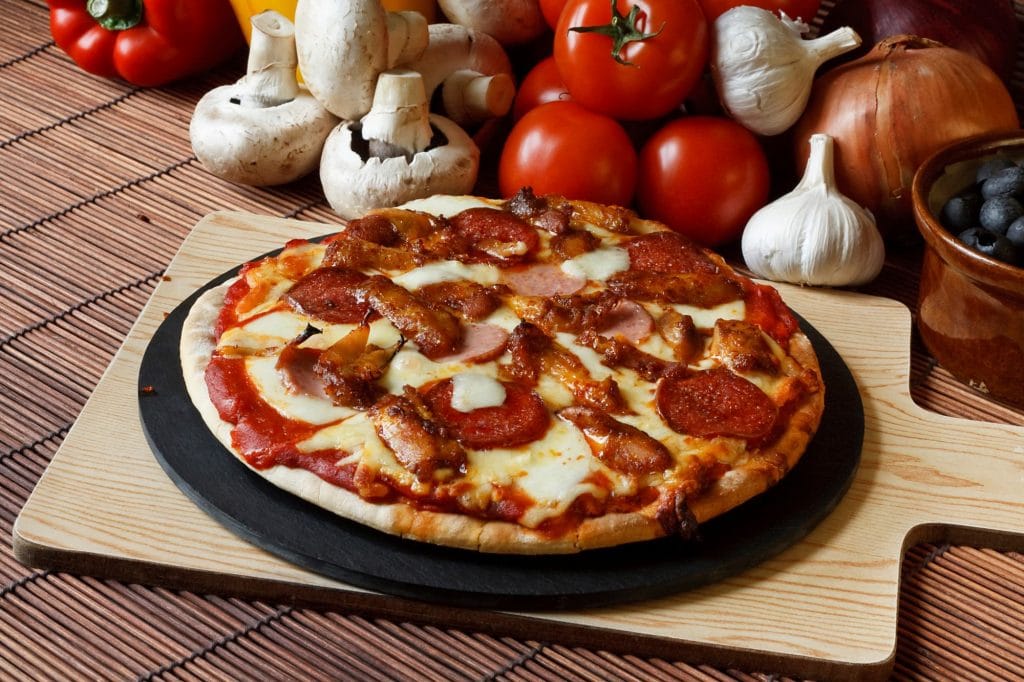There’s no question that homemade pizza is one of life’s sweeter things. But if you’ve ever wondered why it never tastes quite as good as a restaurant-quality pizza, then you might be interested in learning how to use a pizza stone properly.
The best pizza is produced in blisteringly hot oven conditions. But the heat of the air is not all that counts. The temperature of the surface below the pizza is what ensures you end up with a perfectly crispy crust rather than a soggy base.
A woodfired pizza oven is the best way to achieve these perfect pizza baking conditions. But for the vast majority of us home chefs, we’re not lucky enough to have a state-of-the-art woodfired oven in our kitchens. However, the good news is that a pizza stone can replicate a woodfired oven whilst being inexpensive and easy to use.
Here’s everything you need to know about how to use a pizza stone for the first time.

What Is A Pizza Stone?
It is a stone or ceramic slab that can be used in lieu of a baking tray for cooking pizza in your home oven. They are also commonly known as baking stones. The only thing that distinguishes a pizza stove from baking stones generally is its round shape.
The stone material takes a while to heat up but once it does, it holds onto its heat far better than a baking tray. This allows it to transmit heat directly to your pizza dough from underneath.
The thicker the pizza stone, the more effective and durable it is. However, when cared for or used improperly, even the thickest and best quality pizza stones can crack.
How Does A Pizza Stone Work?
You might be wondering what is it about a slab of stone that’s so different from a baking tray? The main advantage of a pizza stone is its tiny cracks and crevices that make it easier for the dough’s moisture to evaporate when cooking.
On the other hand, when cooked on a metal baking tray, moisture is more likely to remain trapped. Instead of producing a crisp and dry base, a pizza cooked on a baking tray is more likely to end up soggy.
How To Use A Pizza Stone Properly
Using a pizza stone the proper way to make delicious and healthy homemade pizza is very simple. This means producing restaurant-quality pizza at home is possible for anyone.
- Insert your pizza stone into an unheated oven.
- With the pizza stone inside, preheat the oven (and your stone) to 240°C.
- Using a pizza peel, place your ready-to-cook pizza directly onto your pizza stone.
- Cook your pizza for 10-12 minutes or until the cheese is slightly browned.
- Use your pizza peel to remove the pizza and don’t forget to switch off the oven.
- Leave the pizza stone in the oven to cool.
- Once it has cooled, brush the stone to clean it.
- How To Look After Your Pizza Stone
While advice varies from manufacturer to manufacturer, there are some typical Do’s and Don’ts when it comes to looking after your pizza stone.
- DON’T season your pizza stone. If you’re wondering should I oil my pizza stone, the answer is no. Your pizza stone is designed to be ready to cook with. There’s no need to sprinkle it with flour or any seasoning yourself either. Your pizza stone may absorb the seasoning, causing it to smoke when heated or give off a bad smell.
- DON’T wash your pizza stone. When your pizza stone absorbs too much moisture, this can cause it to crack. Since pizza cooked on top of the stone becomes completely dry, it is easy to clean the stone simply by brushing it. As well as increasing the risk of cracking, washing your pizza stone will mean it permanently absorbs the washing detergent through its miniature cracks.
- DON’T let your pizza stone change temperature fast. A key risk is cracking your pizza stone due to ‘thermal shock’. This happens when the stone undergoes a rapid change in temperature like going from a hot oven to a cold kitchen bench. Placing a frozen pizza on a searingly hot pizza stone can also cause cracking from thermal shock.
- DO store your pizza stone in your oven. The best way to avoid thermal shock, dropping your pizza stone or someone mistakenly washing it in the sink is to keep it in the oven at all times. The only downside to keeping a pizza stone in your oven is that your oven will generally take longer to preheat. However, the safety of your pizza stone is probably worth this small inconvenience.
- DO be careful when repurposing your pizza stone. You may be wondering what else you could cook on your pizza stone. The temptation is best resisted since pizza stone uses are more likely to cause cracking. For example, searing oily or fatty foods on your pizza stone leads to grease being absorbed into the cracks, increasing the risk of cracking. Searing a steak or roasting vegetables with your pizza stone may work but it is not worth damaging the stone. It is safe, however, to use your pizza stone to cook other kinds of dough, such as flatbreads or English muffins.
A pizza stone is an invaluable kitchen tool that delivers superb pizza on a crisp and evenly cooked base. It is worth taking the time to look after it and use it properly to ensure you don’t damage your key to the perfect pizza.
And of course, for days when you don’t feel like doing the cooking yourself, there’s always 11 Inch. With our extensive delivery options, a gourmet Italian pizza topped with high-quality ingredients could be at your door within the hour. Alternatively, you can make a reservation to dine in at our cosy Little Collins St pizza parlour.



